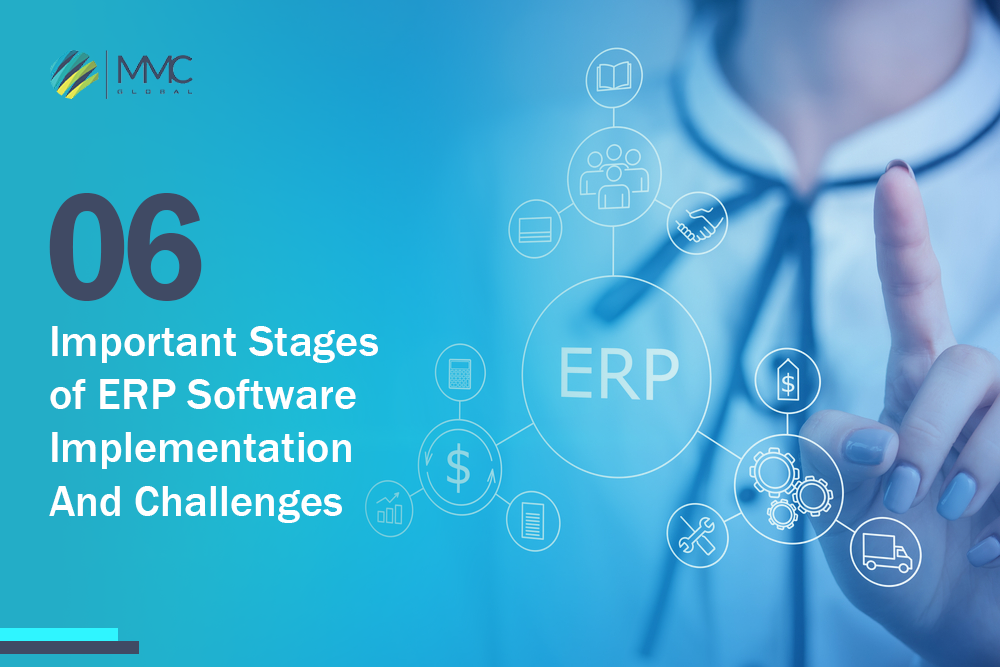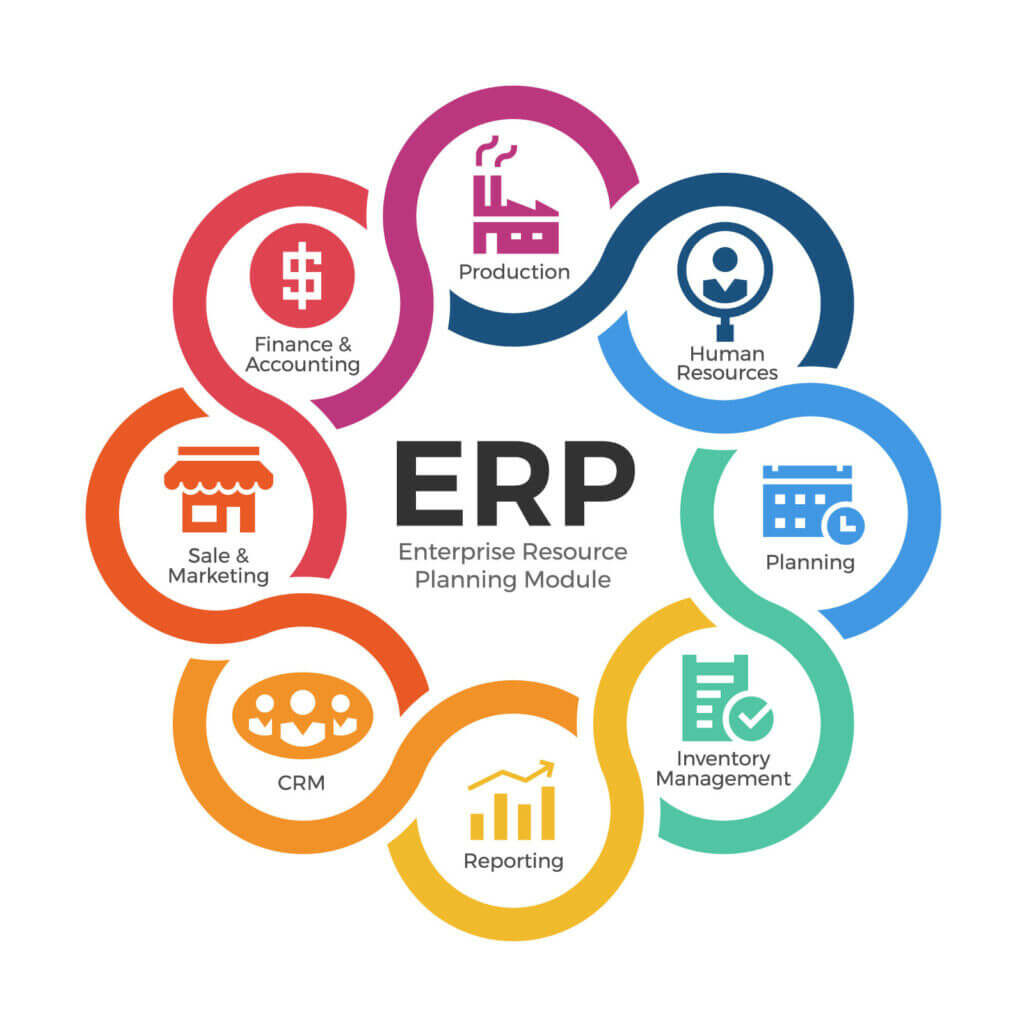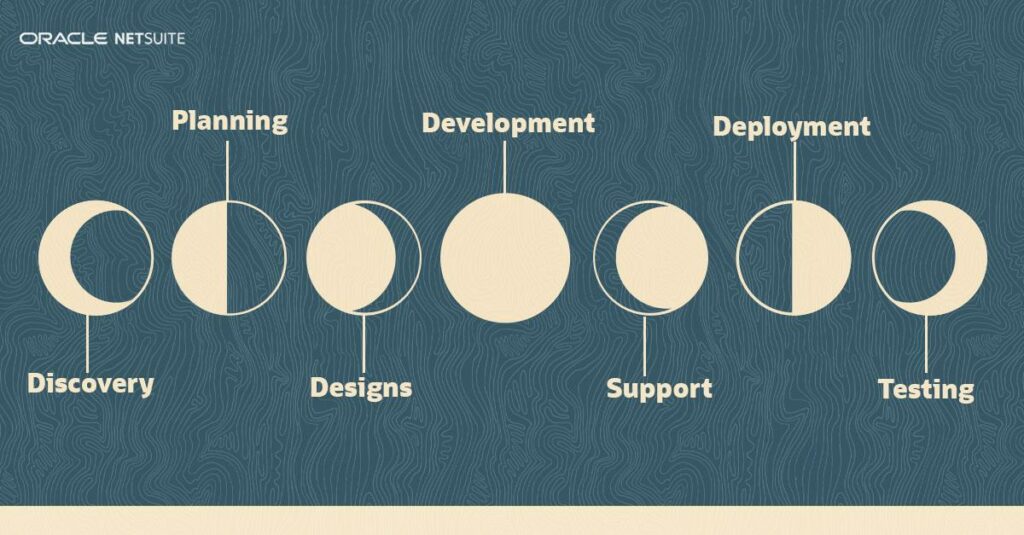6 Important Stages of ERP Software Implementation And Challenges


Enterprise resource planning or ERP software is designed to run extensive operations of major business functions. In today’s era, when businesses are satisfied with technologies, they are more likely to come forward with ERP software implementations. While implementing ERPs, companies need expert resources as it is a complex undertaking that integrates with a major part of the business.
To step on with ERP, you have a strong suit for identifying a major problem. It leads you to develop ERP software, how ERP can be helpful, and do the company stakeholders adopt the system once it is implemented. These are the few questions you must ask yourself before starting the development of ERP software. ERP software development contains six major steps. You must be fair and square about your budgets, resources, technologies, etc.
ERP implementation requires a tenable strategy and planning that gives the road map to the team (ERP designer and developers) to ensure the right workflow of the integrated ERP.
In this article, we will discuss the detailed six stages of key implementation of ERP development. But before jumping over it, Let’s intimate with the basics of ERP software.
What is Enterprise Resource Planning or ERP Software?
The major goal to step up for Building Enterprise Resource Planning or ERP Software is to provide a centralized database that connects multiple groups on the same platform to give a single source of information and accessibility. ERP software can integrate with human resources functions, financials, accountings, marketings, sales, etc.

Custom enterprise resource planning is also a good option to overrun your business. Most companies opt for bespoke ERP solutions after identifying problems and then building an ERP solution to eliminate them. Building an in-house ERP system can be complex and expensive as you need a pool of employees that can help you in this process.
Outsourcing your ERP software development can be cost-effective and trouble-free if you choose the right ERP software development company. As I mentioned, ERP development and implementation is a multiplex task that requires professionals and experts. An outsourcing option can be effective as ERP development companies possess great and talented employees who can easily handle your custom ERP solution project.
You can consider MMC Global, a leading ERP software development company working with leading companies for 20 years. We have huge resources that work to earn money, build trust, and provide quality services to help our client’s businesses grow. We are very concerned about every client’s business goals, understand the need, and give solutions that fill the gap between the success and growth of any business.
Let me explain the 6 major stages that leading ERP development service providers follow to build scalable ERP software development for your business growth.
What are the 6 stages of ERP Software Development & Implementation?
The ERP industry is still seeing tremendous growth; by 2025, analysts anticipate it will reach a value of about $49.5 billion. ERP development and implementation are meticulous and thorough processes containing 6 stages: planning, designing, development, testing, implementation, and support. This whole process overruns the organization, and management ensures the familiarity of each employee or the actual users.
The development of ERP is a compiled request where the inclusion of senior management of different departments of the organization must be necessary. Everyone should be on the same page to initiate development, and the collective interest in the solution must be identified.

Identifying Problem And Planning
The first and foremost step is to plan and discover ideas to develop ERP software against the organization’s problems. The collective exhortation and suggestions are much-needed from the people facing difficulties in achieving their goals.
Call upon the project team to discover main issues, set goals, initiate lead time, assign the task that should be done within given timelines, and ensure other day-to-day project tasks.
An executive, a project manager, and representatives from the departments using the system are usually on the ERP project team. To assist with system design and configuration, the team may also employ a third-party consultant or ERP installation, partner.
It should also incorporate internal experts working on the system’s implementation. Such as an IT professional and a report writer who will provide unique reports for users across the company.
Getting a thorough grasp of present problems, such as process inefficiencies and needs for the ERP system, will be the team’s objective. A speedier financial closure, a better understanding of operations, or getting ready for an IPO are just a few examples of the broad business concerns and implementation goals that may have been outlined if the firm has previously created an ERP business case. These can concentrate on system development and guide additional in-depth studies, including documenting current routines.
As the organization establishes a clear understanding of its requirements, the team may choose and purchase an ERP system at this phase. Choosing an on-premises or cloud-based ERP solution is a significant choice. You acquire and set up hardware and software for an on-premises system in your business’s data center. The adoption of cloud-based ERP, on the other hand, is simple. It requires less internal IT experience because it is often provided as a subscription service accessed online.

ERP Software Design
While starting with the design after gathering lots of ideas, you need to hire strong UI UX designers who can plan and initiate low-fidelity designs. It is important to keep a loop in all the users so they can deliver feedback on the workflow of the ERP solution.
Design helps us identify the software and application workflow. It is considered one of the intricate stages upon which development depends. There are a few steps that our designers follow, such as
- creating user flows
- Stepping on with low-fidelity design
- Getting framework implementations
- Building high-fidelity designs
- Adding prototyping, then jumping for testing
- and lastly, hand it over to the development team
Get more info: Top 7 Best Free and Open Source ERP Software
ERP Software Development
In these stages, developers come to the ground and make the design functional by using futuristic programming language, frameworks, and other third-party integrations. To make your design viable, companies depend upon a huge development team that must be efficient and experienced simultaneously.
88% of companies consider their ERP implementation a success, which can not happen without an expert development team. Developers use their utmost skills to build robust and multi-feature ERPs using advanced and modern ERP frameworks. It can be software integrated into the hardware and provides accessibility for various hands.
In some cases, companies order to add high-priority modules and make MVP for initial use and beta testing. Few want fully-completed and intricate modules that represent successful ERP solutions.
Moreover, if a company wants to migrate one ERP to the latest ERP, it can also migrate the database to eliminate legacy systems in the business operations. The migration process involves a few ambiguities, including extracting data, transformation, and conversion from multiple server systems.
Testing And Quality Assurance
Concurrent testing and development are possible. For instance, the project team may test particular modules and features, make corrections or revisions in light of the findings, and then retest.
A different ERP module might be tested while another is still being developed. Initial testing of the software’s fundamental features should be followed by thorough testing, including letting certain employees use the system for regular tasks. This step needs to involve end-user orientation training as well as testing of the moved data.
Software quality assurance teams are responsible for conducting possible testing and retesting of all features and functionalities. The concerned testers apparently start creating test cases and generate regular reports in which bugs and errors are found. The aim of delivering those reports to the developers is to ensure the fixation of all glitches and mistakes.
Implementation Of ERP Solution
After completing designing, development, and testing, your product is ready to market. However, be prepared to train and answer loads of questions because users interact for the first time, and they need user guidance in their initial stage.
You may encompass questions as your company is going to use a newly made customized ERP that will probably decrease concerned problems. It is better to create a user manual and conduct a training session to introduce business ERP and make sure the presence of developers as they have a good command and knowledge that encourage users to utilize ERP solutions.
However, the adaptation of new technology can proceed in the long run. Some companies run previous or old systems parallel with newly built technology, so people who are baffled take time to learn the latest one.
Support and Maintenance
No matter how powerful your ERP is, you just need support with frequent fine tunes and upgrades to make your ERP unintrusive. After deployment, it’s important to maintain your ERP implementation to ensure users are satisfied and the company reaps the expected advantages.
During this phase, the project team will be in charge of the ERP system, but its attention will now be on gathering user input and modifying the system as necessary. Further development and setup may be required to add new features to the system. Additionally, the system will require training for new employees.
If your ERP system is on-premises, you will need to deploy software updates on a regular basis and maybe upgrade your hardware as well. If you’re utilizing a cloud-based ERP system, your vendor could update the program automatically.
Get more info: What Are ERP Solutions? Why Should Businesses Invest In ERPs?
7 Key ERP Implementation Challenges
Considering a few challenges before starting development helps you understand the intricacy of ERP software development. There are a few key challenges that you need to be aware of to make yourself mentally prepared.
Managing Project
To handle ERP projects, you have to build a strong team that includes experienced experts to overcome task backlogs and division of tasks. Moreover. to keep track of all functions that are viable for completing projects. ERP projects are perplexing and comprise multiple defined objectives such as discovery and planning, design, development, data migration, testing, deployment, support, and post-launch updates. A great collaborative team can be challenging throughout the process.
Manage your project by increasing the cohesiveness of the team, and start using project management tools that can help you and your employees collaborate. And also, you can keep your clients in the loop.
Strategizing Your Project
Businesses frequently underestimate the amount of time and money required for a successful deployment. Scope creep, when a company adds capabilities or features to the system that weren’t originally planned and underestimates personnel demands, are two of the most frequent reasons for budget overruns, according to Statista.
Those problems may be avoided by creating a clear and practical strategy. This decision-making process will be streamlined, and the project will stay on track with the help of a realistic project plan that anticipates potential hiccups and minor cost overruns and deals with them beforehand.
Data Integration
ERP offers a single, reliable source of data for the whole company, which is one of its main benefits. Data migration often entails transferring information from several outdated systems into the ERP database. That is a crucial phase in the deployment of ERP. However, you must first locate all of your data. You could find that this is a lot harder than you thought. The data may be dispersed around the business, hidden in accounting software, department-specific programs, spreadsheets, and sometimes even on paper.
The complete ERP installation project may remain on schedule and under budget with the aid of well-planned data migration. Additionally, it provides a chance to remove duplicate and outdated data that may be hiding in the organization’s older systems.
Data Quality
The company may begin considering data migration to the ERP system once it has identified all of the data sources. But doing it could require a significant data management operation. Organizations frequently have duplicates of the same information in their systems because different departments work with the same clients, goods, and orders.
Discrepancies in the information may also exist, such as misspellings of names or addresses. Some of the information may also be outdated, such as clients’ lists or vendors who have subsequently not retained.
Before migrating data to the ERP system, ensuring data quality can turn into a significant job in and of itself. It involves evaluating the data, eliminating duplicates, and adding missing information. Before making the new data operational with the ERP system, it should also be properly assessed. Make sure your team is aware of the significance of data cleanup, and assign specific tasks to each member. For instance, the accounting team will handle all financial data, while customer service will clear up all client data.
Never-Ending Optimization
All software and applications must need upgrades, maintenance, bug fixation, and all possible stuff to make a robust ERP solution. Many expert ERP software development companies help you build your ERP and provide lifetime support for their clients.
They take ERP implementation seriously as most of the ERPs totally run business operations, and without that, it is difficult to proceed with major functions. You have to set out an operational budget and ask your hiring ERP development service provider to provide support and maintenance.
Businesses frequently use ERP systems for more than ten years after implementation. So it’s critical to conduct regular evaluations to see whether the system is still serving the organization’s goals. Leading cloud-based systems instantly make new features and improvements available to customers and are easier to upgrade than older on-premises systems. It’s important to regularly evaluate whether it would be preferable to stick with the present system or start the labor-intensive process of selecting a successor because an obsolete ERP system may begin to hurt the firm.
Learn about ERP’s Pros & Cons: Enterprise App Development Frameworks + Advantages & Disadvantages
Bottom Line
ERP software implementation is such a complex and prolonged process for any business. If you hire experts and professionals, there is a big chance that you can get highly effective ERP software to run your business operation. MMC Global helps you provide the right ERP software at the right time, no matter how challenging. We have a huge team of experts who can help you understand your business goal, what problem arises, and what will be the best solution to compete with you in this modern market.
Get started today and have an opportunity to grow your business exponentially. ERP software is effective at a large scale, maximizes revenue, manages customer data, and automates the whole business process to meet your business goal.



